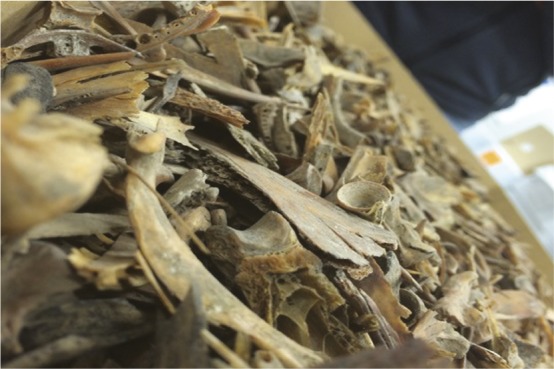Genome analysis of dog breeds reveals insights into athleticism
Hunting dog flushes a game bird. Image courtesy of iStock/JMichl.
The American Kennel Club, an authority on purebred dog registration in the United States, sorts 189 of more than 450 worldwide dog breeds into seven major groups along a spectrum of characteristics. Jaemin Kim et al. (pp. E7212–E7221) used whole-genome sequencing to compare two groups at each end of the spectrum. One group, terriers, comprises small, feisty dogs originally bred to ferret out vermin from urban and rural settings, whereas the other group, sport hunters, is composed of athletic dogs originally bred to assist humans in hunting game. Analysis of whole-genome sequences from 21 sport hunters and 27 terriers, as well as publicly available sequences of 79 village dogs, which were used for comparison, revealed that 59 genes were under strong positive selection in sport hunters. The genes are implicated in muscle development and contraction, heart rate, blood circulation, neuronal functions, and learning ability. A single nucleotide variant within the ROBO1 gene, implicated in dyslexia, was tied to performance in an obstacle course, a test of canine agility, with the advantageous allele being selected in sport hunters. In contrast, the genes OXR1 and SHANK2, both implicated in hyperactivity and startle responses, were under positive selection in terriers, which are known for noise sensitivity, alertness, and territoriality. Further, analysis of sequence data from 92 racing Whippets revealed that a mutation in the TRPM3 gene, involved in blood vessel contraction, was tied to the dogs’ speed and racing grade. According to the authors, identifying selective pressures on the genomes of athletic dog breeds might provide tantalizing hints to the potential genetic basis of athletic performance in humans. — P.N.
Ancient DNA reveals past biodiversity and human impacts

Unidentifiable bone fragments from Wairau Bar.
Researchers have put forth numerous theories regarding the impact of human arrival on biodiversity. Studies of New Zealand, the last major landmass to be settled by humans, may help shed light on early human–faunal interactions. Frederik Seersholm et al. (pp. 7771–7776) analyzed ancient DNA from more than 5,000 bone fragments representing 38 paleontological and archaeological bone assemblages throughout New Zealand. The authors identified 110 different species, including birds, fish, marine mammals, reptiles, and amphibians. Five different whale species were identified in archaeological sites: orca, true dolphin, Cuvier’s beaked whale, fin whale, and southern right whale. Except for the southern right whale, these species had not been previously identified in an archaeological context. The authors also identified 10 different genetic lineages of the kākāpō, a flightless parrot. Only two of these lineages had been previously identified in samples from the mid-19th century onward, suggesting that indigenous human activities may have reduced kākāpō genetic diversity prior to European arrival. DNA from the extinct Markham’s frog suggested that this frog species was once widespread and helped establish its relationship to extant frogs. According to the authors, the findings provide insight into the impact of human arrival on New Zealand biodiversity and highlight the value of ancient DNA analysis of bone assemblages. — B.D.
River discharge and coastal sea-level changes

Mid-Atlantic coast of the United States. Image courtesy of Flickr/NASA Goddard Space Flight Center.
Despite its influence on coastal ocean circulation, river discharge has often been overlooked as a driving force behind sea-level change. Christopher Piecuch et al. (pp. 7729–7734) examined the relationship between river discharge and sea level along the US Atlantic and Gulf coasts based on data from tide gauges and river stations collected between 1910 and 2017. Sea-level rise per cubic kilometer of annual river discharge varied from 0.01 cm in the Gulf of Mexico to 0.08 cm in the Gulf of Maine. The authors formulated a theory that explains the dependence of sea level on river discharge in terms of Earth’s rotation, river discharge, and the offshore density gradient resulting from freshwater–saltwater mixing. Predictions of sea-level rise per unit river discharge based on this theory yielded lower values than those estimated from observations. However, the theoretical values were on the same order of magnitude as the observational values, suggesting a causal relationship between river discharge and sea level. The results highlight a significant but frequently overlooked driver of coastal sea-level change and have implications for remote sensing and climate-driven modeling of sea-level changes, according to the authors. — B.D.
Urban mobility and residential segregation
Neighborhood segregation in cities is a well-recognized phenomenon, but the extent of isolation of residents in disadvantaged neighborhoods from resource-rich neighborhoods remains unclear. Qi Wang et al. (pp. 7735–7740) used social media messages to study urban mobility in 50 of the largest US cities. The authors analyzed more than 650 million geocoded Twitter messages to identify nearly 400,000 city residents and deduce their travel from October 2013 to March 2015. The geocoded messages enabled the authors to determine the users’ mobility patterns within each city’s commuting zone. The study revealed high consistency in the average travel distance and number of neighborhoods visited among individuals from neighborhoods of different race and income characteristics. However, significant differences emerged in the composition of neighborhoods visited regardless of the residents’ income level, with residents of primarily black and Hispanic neighborhoods being less likely than residents of primarily white neighborhoods to travel to nonpoor or white middle-class neighborhoods. Furthermore, residents of poor white neighborhoods were consistently isolated from nonpoor white neighborhoods. The study suggests that residential isolation and segregation persist even though residents of disadvantaged and advantaged neighborhoods exhibit similar urban mobility profiles. The findings carry implications for understanding interactions across urban neighborhoods, according to the authors. — C.S.
Primary producers in the mid-Proterozoic sea

Chromatographic column with pink-colored porphyrins. Image courtesy of the Australian National University.
Approximately 1.8 to 0.8 billion years ago, in the mid-Proterozoic Eon, Earth’s oceans contained virtually no animal life. A complex ecosystem requires sufficiently large primary producers, such as phytoplankton and algae, to provide the flow of trophic energy that would support animal life. Researchers have hypothesized that the mid-Proterozoic ocean may have lacked such large producers. N. Gueneli et al. (pp. E6978–E6986) examined porphyrins, fossil chemical signatures of the photopigment chlorophyll, from 1.1-billion-year-old shales in Mauritania. Analysis of nitrogen isotopes in the porphyrins revealed signatures suggesting that cyanobacteria may have been the dominant form of primary producers. Further evidence from fossil carotenoid pigments suggest that green and purple sulfur bacteria may have also served as primary photosynthetic producers. Although the shales contained eukaryotic microfossils, failure to detect sterane fossil molecules that would indicate eukaryotic contribution to biomass suggests that algae may have played a minimal or insignificant role in the oceans around 1 billion years ago. According to the authors, a lack of large primary producers in the mid-Proterozoic oceans, along with low oxygen levels, may have hampered the development of animal life. — P.G.



